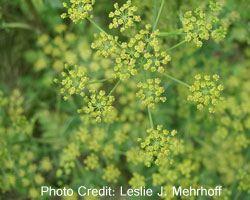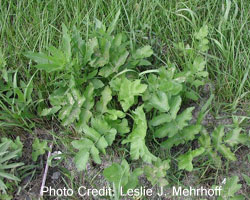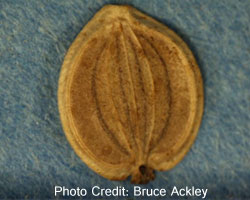Invasive Species
Invasive Species
Wild Parsnip
This is wild parsnip – a.k.a. poison parsnip. It is a growing concern in Ontario and in Kingston. This invasive weed is often found in roadside ditches, uncultivated land – and along nature trails.
If you see wild parsnip, stay away from it. Why? Because the sap of the plant contains chemicals that can irritate skin and eyes and cause severe burning and blistering on affected skin when it is exposed to the sun. The blisters, which can result in permanent scarring, may occur one to two days after contact with the plant.
Interested in wild parsnip? See this Ministry of the Environment fact sheet.
How to identify wild parsnip
Wild parsnip is a highly branched plant, with hollow green stems. It has two growth stages: non-flowering leafy rosettes at ground level and 0.5 to 1.5m-tall flowering plants. In the first year of growth, low-growing non-flowering rosettes of leaves form with a cluster of spindly, compound leaves that resemble celery leaves. Second and third-year plants have tall, branched flowering stalks that usually bloom in early June to late July. Seeds are flat and round. The seeds can lie dormant for years making it even more challenging to control.
How to avoid wild parsnip burns:
- When working around wild parsnip or when walking through dense vegetation, wear goggles, gloves, long pants and long-sleeved shirts. Thoroughly wash boots and gloves with soap and water before taking off your protective clothing.
- Children should be reminded not to pick wild flowers. Ensure children are able to identify wild parsnip in order to avoid exposure.
- If you are exposed to the plant sap, wash the contaminated area(s) thoroughly as soon as possible, and seek medical attention if skin irritation occurs.
Important safety information on wild parsnip hazards, control and disposal is available on the Ontario's Invading Species Awareness Program web site.
What the City is doing about wild parsnip on public property
The City has efforts in place to manage this weed on municipal property. Given the prevalence of this invasive species, eradication is not a viable option.
- Trails and roadsides: City crews regularly mow beside nature trails and roadsides and know to target wild parsnip. For this reason, it is recommended trail-users – and their children and pets – should stay on the path and not wander onto naturalized areas.
- Parks and public areas: municipal parks and public areas are mowed weekly. Naturalized areas immediately adjacent to public areas, are monitored for wild parsnip.
Disposing of wild parsnip
Wild parsnip on your property is your responsibility. For strategies to remove wild parsnip on your property see this Ministry of the Environment fact sheet.
Do not burn or compost wild parsnip plants that have been cut down or dug up. If possible, leave the stems to dry out completely at the site. Carefully dispose of plant material in black plastic bags and leave in direct sun for a week or more. Bagged wild parsnip is acceptable as waste at various waste disposal site. Wild parsnip will not be accepted in the green bin program or at the leaf and yard waste site."
Thanks to the City of Ottawa for sharing its information on this subject with us.
Giant Hogweed
Giant Hogweed is an invasive species native to Asia which is becoming more common across North America. The sap of these plants can cause severe burns if not handled correctly. Find out more about Giant Hogweed.
Disposing of Giant Hogweed
Do Not Burn. Do Not Compost. Carefully remove flower heads from stems and place them in black plastic bags. Make sure not to drop any seeds while you are doing this. Seal the bags tightly and leave them in direct sunlight for about a week. Allow stems and roots to dry out thoroughly before disposing of them. Bagged Giant Hogweed is accepted at a number of waste disposal sites in Kingston. Giant Hogweed is not accepted in City green bins or at the leaf and yard waste site.



